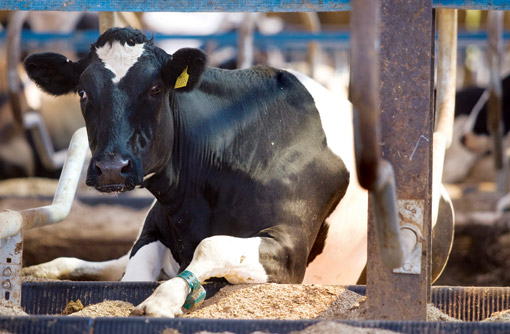Improve cow comfort to boost productivity

Making small adjustments to existing cubicles could help improve cow comfort and increase milk yields
Almost half of farmers in a recent survey admit they see cows perching in cubicles – an indicator of poor cow comfort that reduces lying times, increases lameness risks, and limits milk production.
But often, simple adjustments will ensure cows are lying correctly in cubicles for longer, according to Kingshay technical manager Peter Shipton.
Kingshay’s recent Cow Comfort survey revealed 47% of dairy farmers see cows perching – where they stand half in the cubicles. A further 18% of respondents saw this behaviour frequently. In addition, 39% saw cows lying too far forward in cubicles, and 34% saw swollen hocks. But farmers also report seeing diagonal standing or lying, dog sitting and damaged knees.
“All of these indicate different issues with cubicles and are things farmers can easily assess in their own herds,” says Dr Shipton. “It may be almost impossible to eradicate them completely, with cows inevitably being slightly different sizes and having to use the same accommodation. But with good cubicles that are set up properly and bedded appropriately, cases should be rare.”
The survey also found 24% of farmers admit lameness is their greatest health concern, with only fertility scoring higher.
“Lameness in housed cows often results from cows spending a lot of time standing on concrete, and when cows perch, they are putting extra weight on their back feet, further increasing lameness risks.
“Comfortable cubicles will encourage cows to spend more time lying down and reduce lameness risks. They should lie down for 14 hours a day and when more than 10% of cows at rest are seen standing it can indicate the cubicles are less comfortable than they should be.
“It’s not about cubicle age or material, as old or wooden cubicles can work well,” he explains. “The basic cubicle size and positioning of head and rump rails are the most important factors, followed by a suitable bed surface or adequate bedding material.”
Cows should be able to stand with all four feet in the cubicle. “Perching usually suggests that neck rails are incorrectly set up. It can be too low or too far back towards the kerb and possibly both.”
Adjustments to improve cow comfort
The key measurements are the diagonal between the kerb and the neck rail and the height of it above the bed surface. For individual herds these will vary depending on the average size of the animals to be accommodated.
“On most cubicles the distance from the kerb to the neck rail can be altered, but you might need to be imaginative and weld on brackets to achieve the ideal height above the bed. We’ve worked with members to come up with a range of solutions in their different circumstances and found even a 5-8cm change can help and that’s saved them having to buy new cubicle divisions.”
When cows are seen lying too far forward in cubicles, it might be tempting to move the neck rail back towards the kerb, but this is not the right solution, warns Dr Shipton. “Cows lying too far forward can make it difficult for them to lunge forward to stand up and can mean muck on the beds, increasing mastitis risks.
“This is usually because the brisket board or rail is missing or in the wrong place. Brisket boards don’t need to be very high, 10-12.5cm is usually enough, but they do have an important role in cow positioning and keeping cubicles clean.”
Replacing cubicles – considerations
When cow comfort is poor and these changes can’t be made to cubicles or they are damaged or rusty and beyond repair, replacement may be the only option. “When you are sourcing new cubicles, remember to choose carefully, because you want them to be suitable for many years of use,” advises Dr Shipton.
There are a wide range of designs available, with some fixed and some allowing easy adjustment, he advises. “Our cubicle demo unit here at Bridge Farm, where we have 17-18 different cubicle divisions installed, proves that some are more popular with cows than others, so ideally try and see some already installed and in use on a farm with a similar cow type and size.
“The cost of a cubicle is an important consideration, but cheap ones might be a false economy if they are the wrong size or don’t allow you to adjust them to suit your cow size. You may also want to be able to re-adjust them should cow size change or if you want to use them for a heifer group.”
Swollen hocks also indicate poor cow comfort and can reduce lying times, but Dr Shipton believes these are more likely caused by worn-out beds or too little bedding. “When you see swollen hocks and there are mats or mattresses installed, they may be worn out and need replacing.
“When the reason is inadequate bedding, using more may be worth the additional cost or switching to a different material that’s cheaper or more readily available can help. Sand is becoming a popular bedding material because it can provide excellent cow comfort and reduce mastitis risks. But it is not suitable for every farm and needs managing carefully.
“The best way to test the comfort of the bed surface is to drop on to your knees on it. If you are not prepared to do that, then it is probably not right for your cows either,” he says.
What does cow behaviour says about cubicle comfort?
Perching
Cubicles too short – move neck rail up or forward.
Lying too far forward
Bed area too long – brisket board or rail is missing or incorrectly set.
Swollen hocks
Surface rough or not well padded – install or replace mats or mattresses or use more or different bedding material.
More information on cow comfort our dedicated academy on building design
